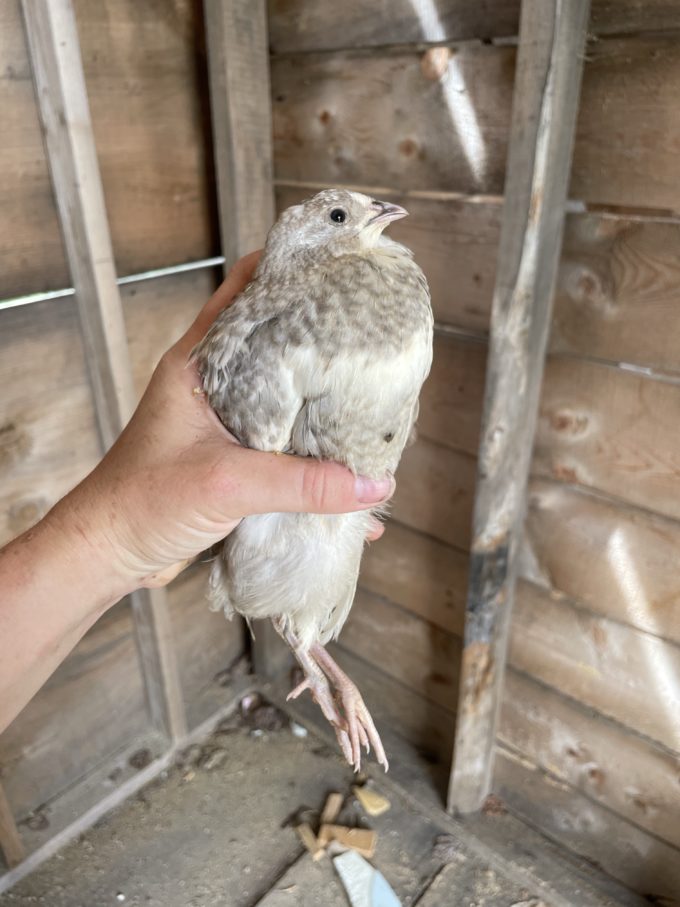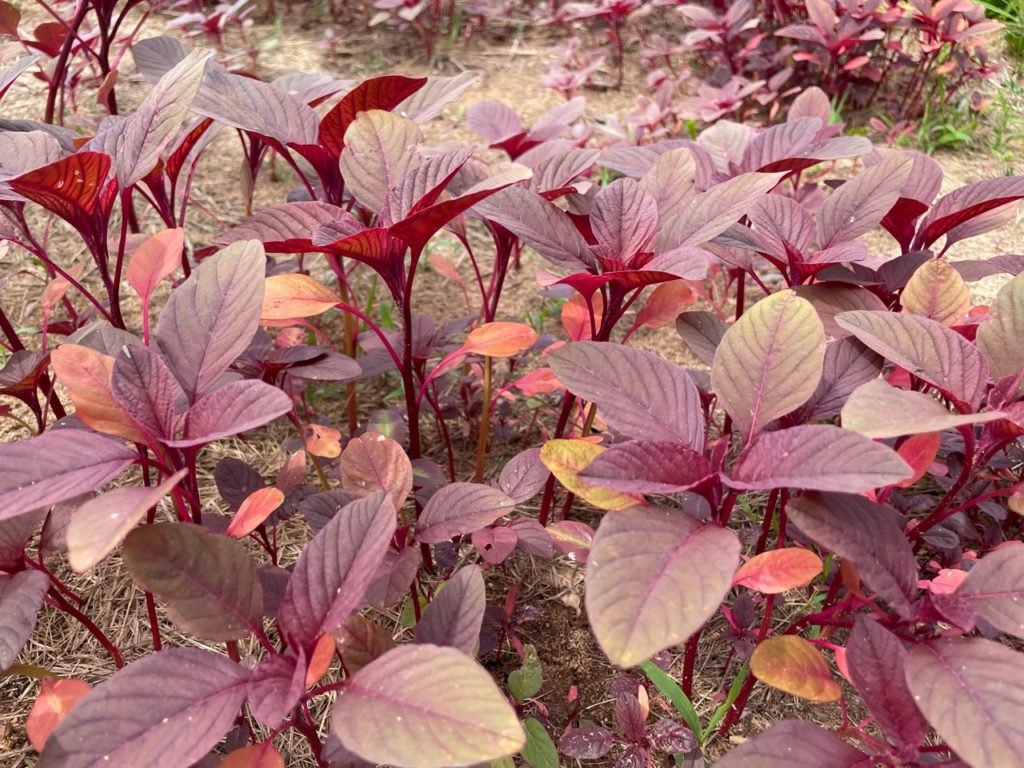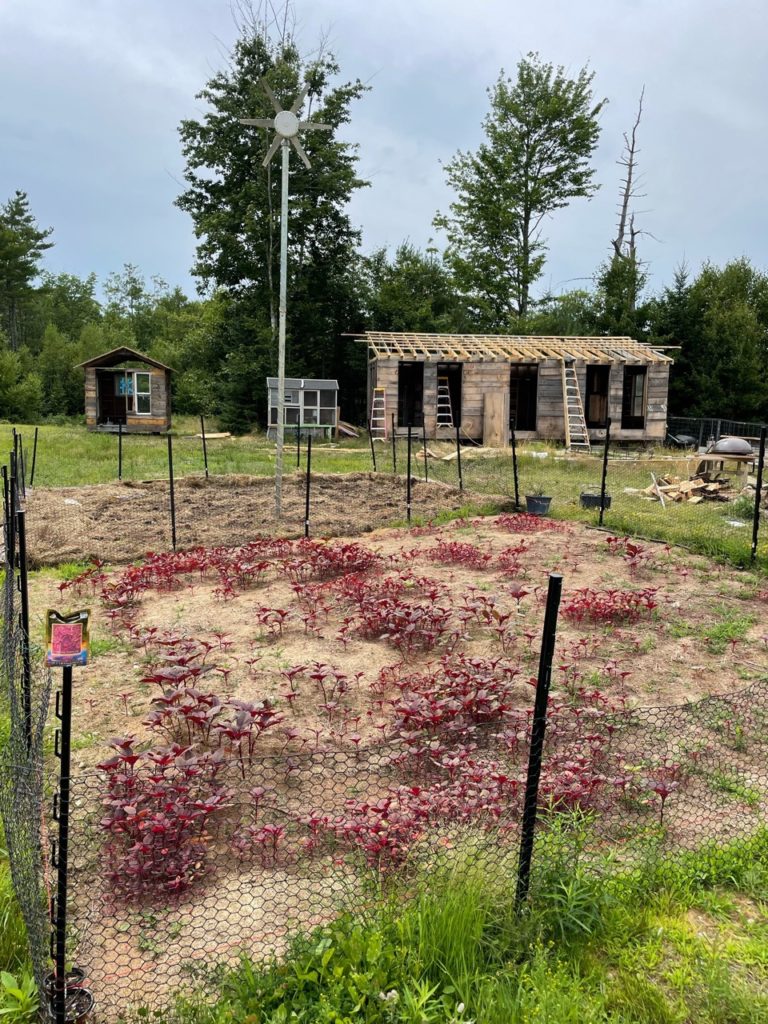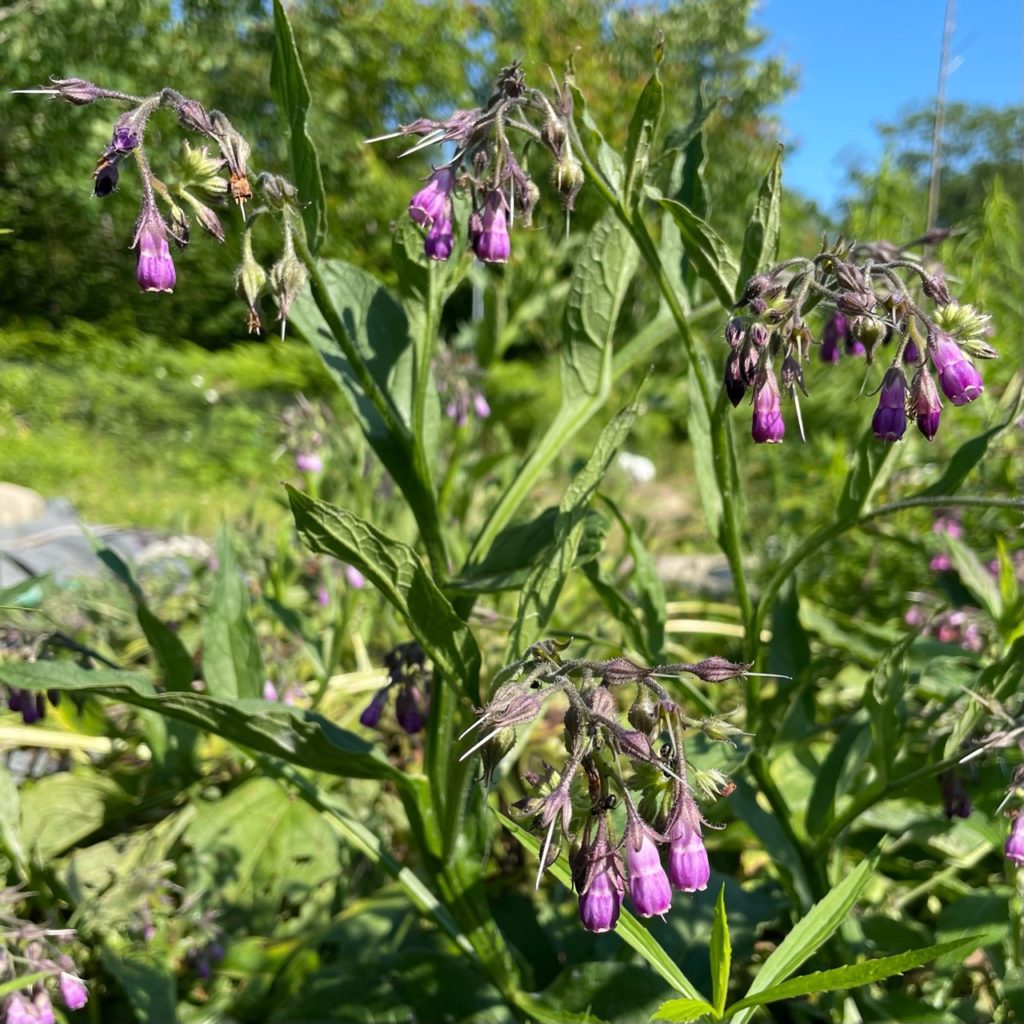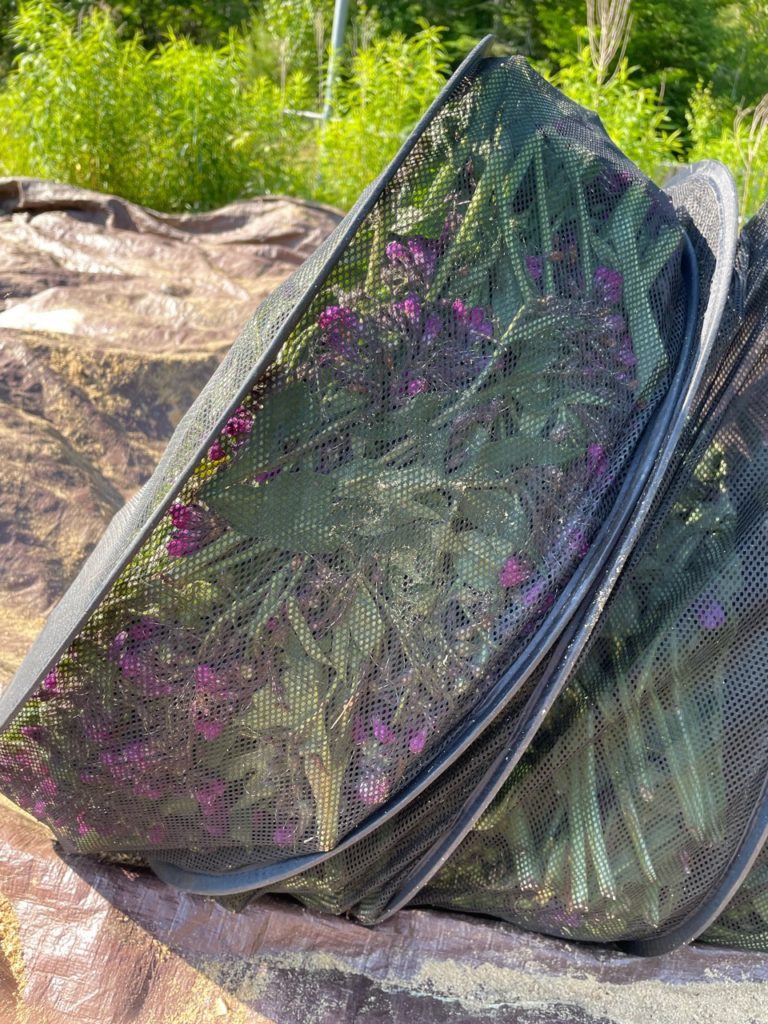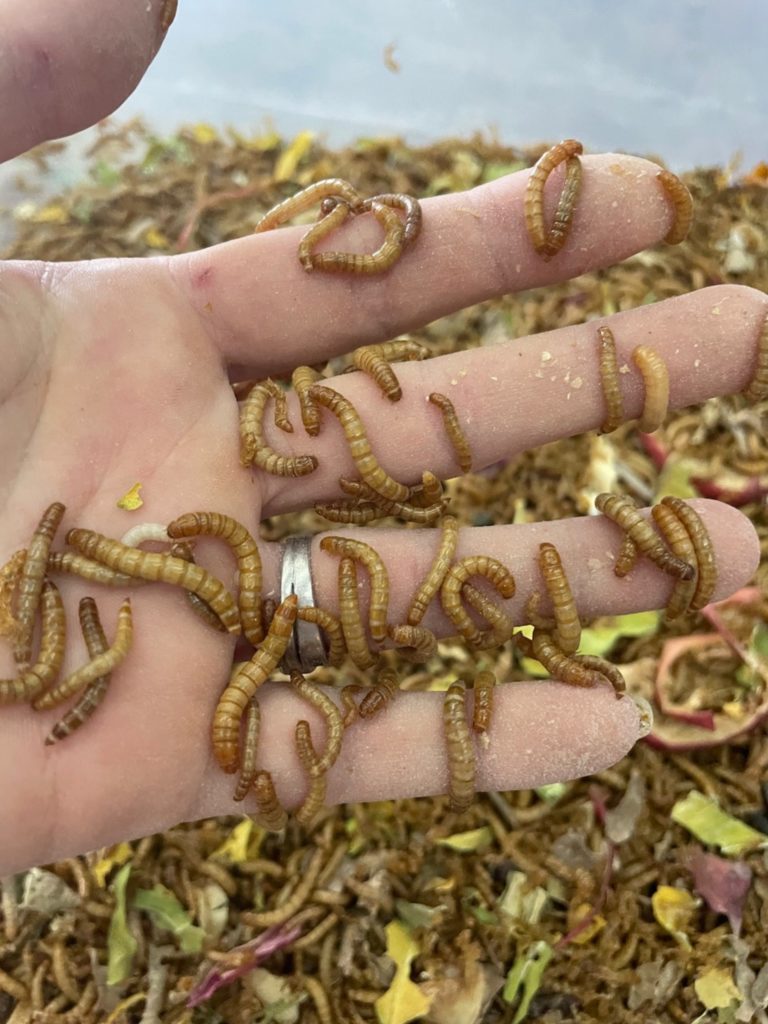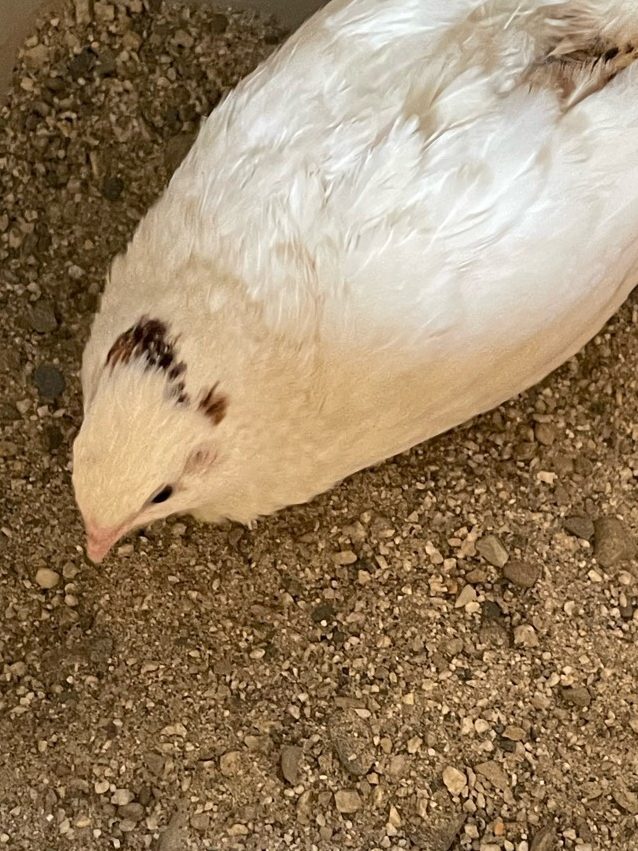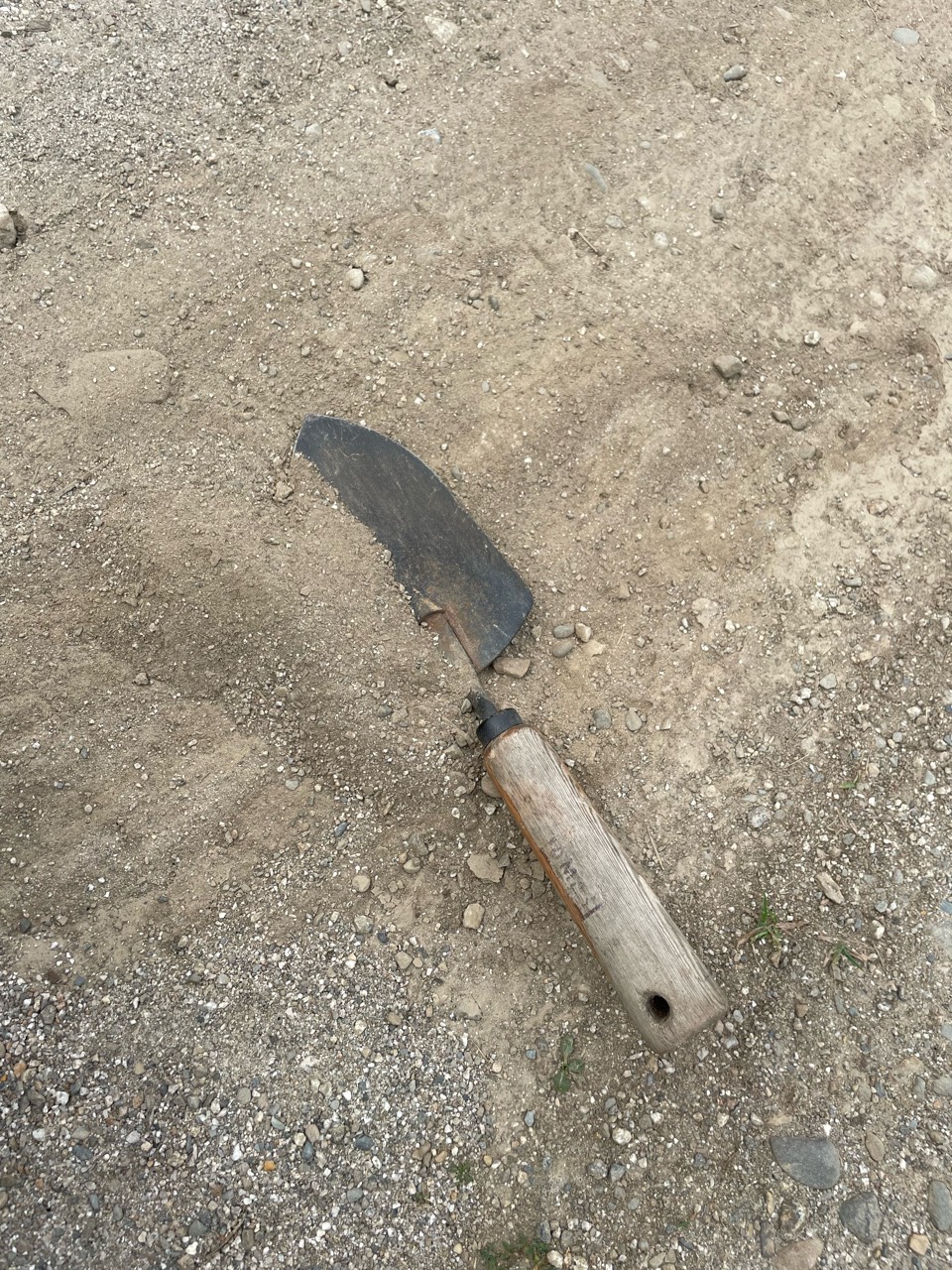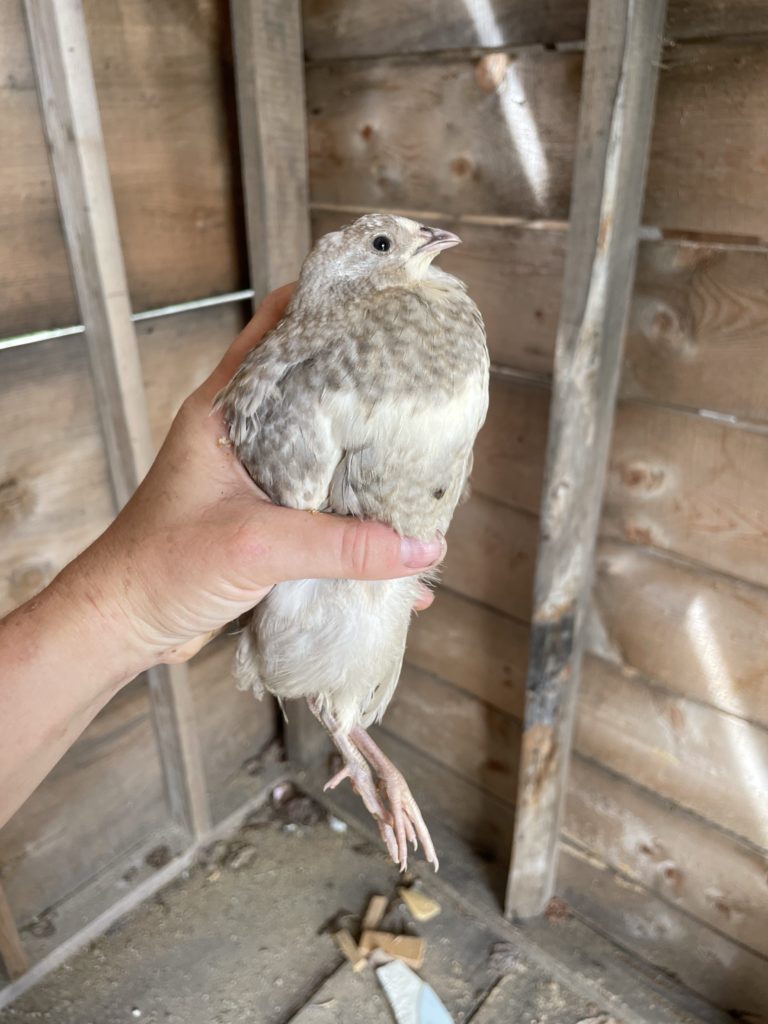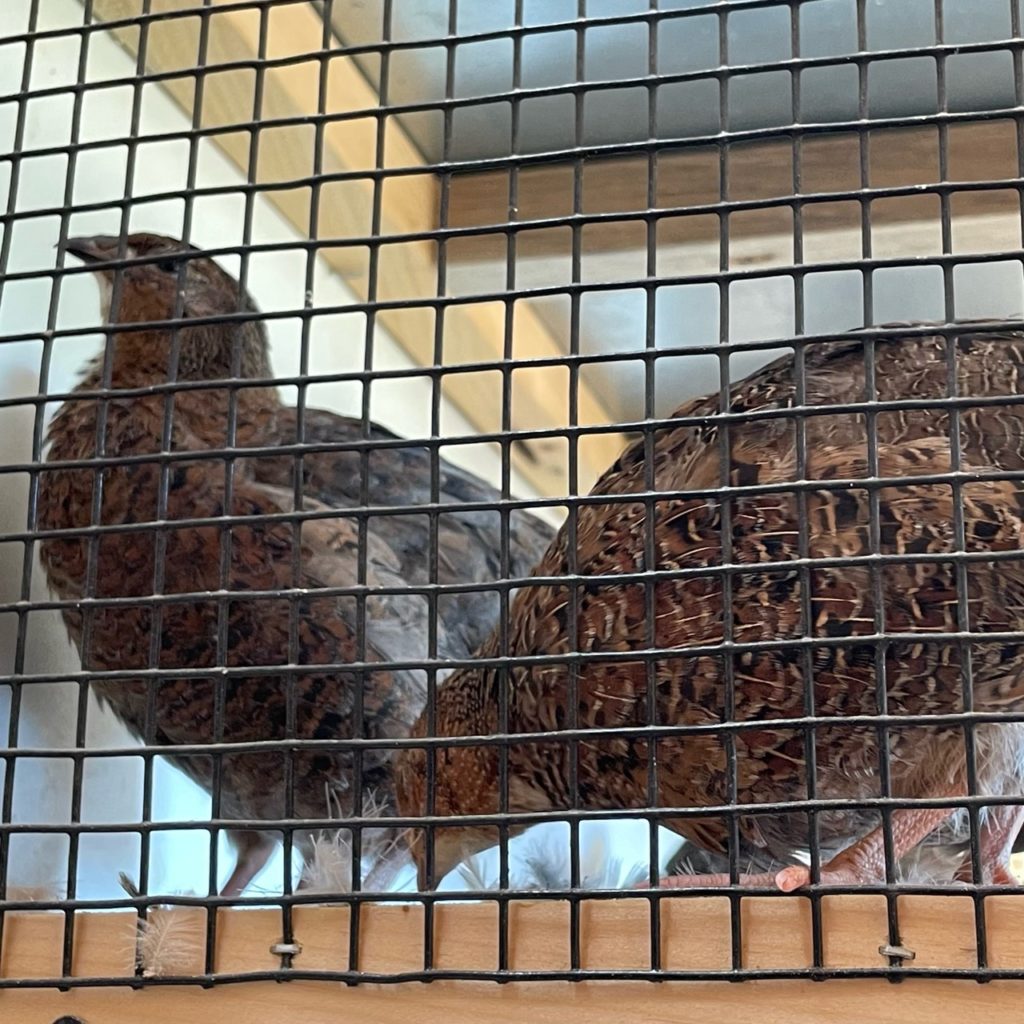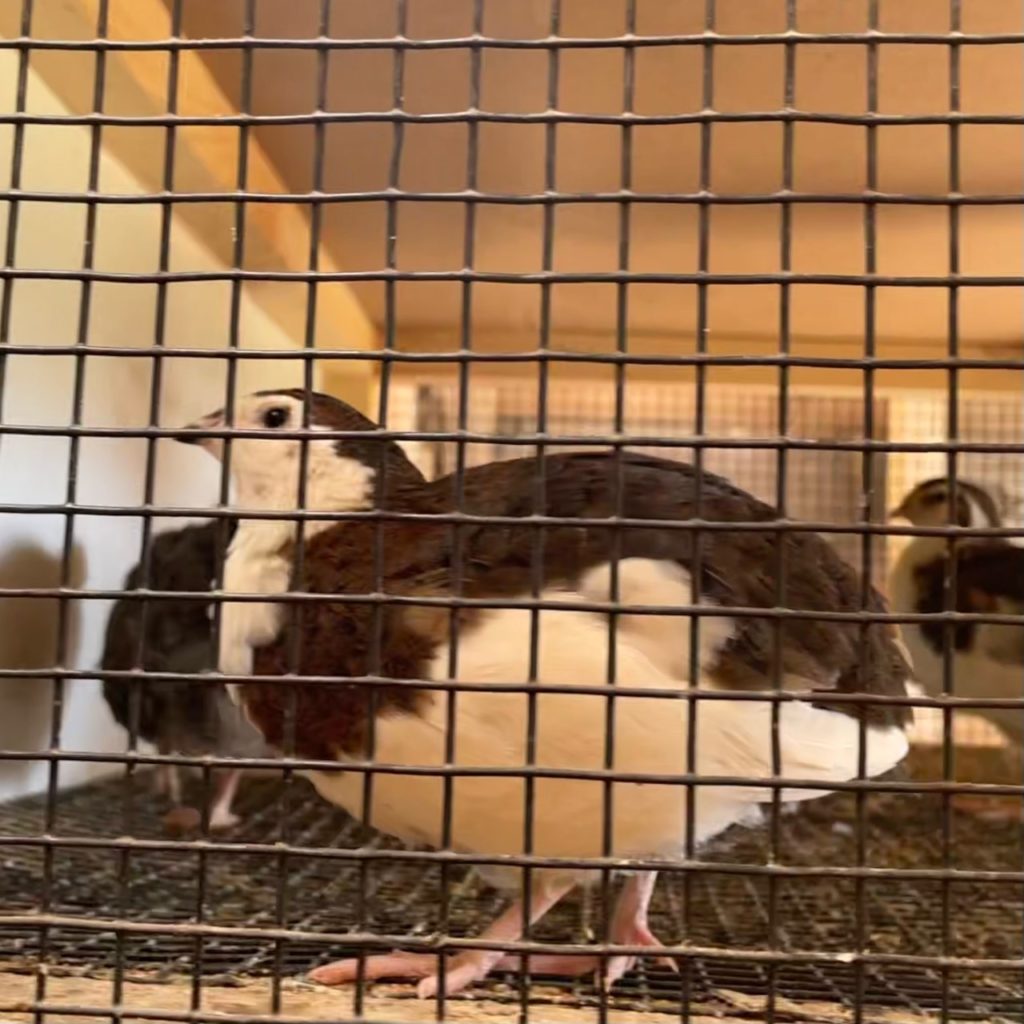LAST UPDATED ON SEPTEMBER 11, 2023
Tired of waiting for your chickens to lay eggs? Most chicken breeds take 21 days to hatch then another 6-8 months to lay eggs. Celadon quail hatch in only 17 days and start laying between 6-8 weeks old. Males can be harvested between 5-6 weeks as a food source. Yes, you read it right. Read that again if you need to. This article is intended to inform you about this species of domestic quail, and if quail are a good fit for your homestead.
What should I know before buying quail?
This is a question worth investigating, as you should before purchasing any livestock or pet.
When I research, I dive deep. I wrote this article based on many sources while researching quail for our farm. This includes the breeders I’m purchasing from, co-operative extension pages, and three local breeders here in Maine for climate-specific housing information.
Do quail make a good homestead animal?
Quail Perks
- No roosts
- No nesting boxes
- No loudly crowing roosters
- Rapid hatching & maturity
- Freaking adorable blue eggs
- Delish delicacy harvested at 5-6 weeks
- Nutritious eggs with many health benefits
Are you kidding me?
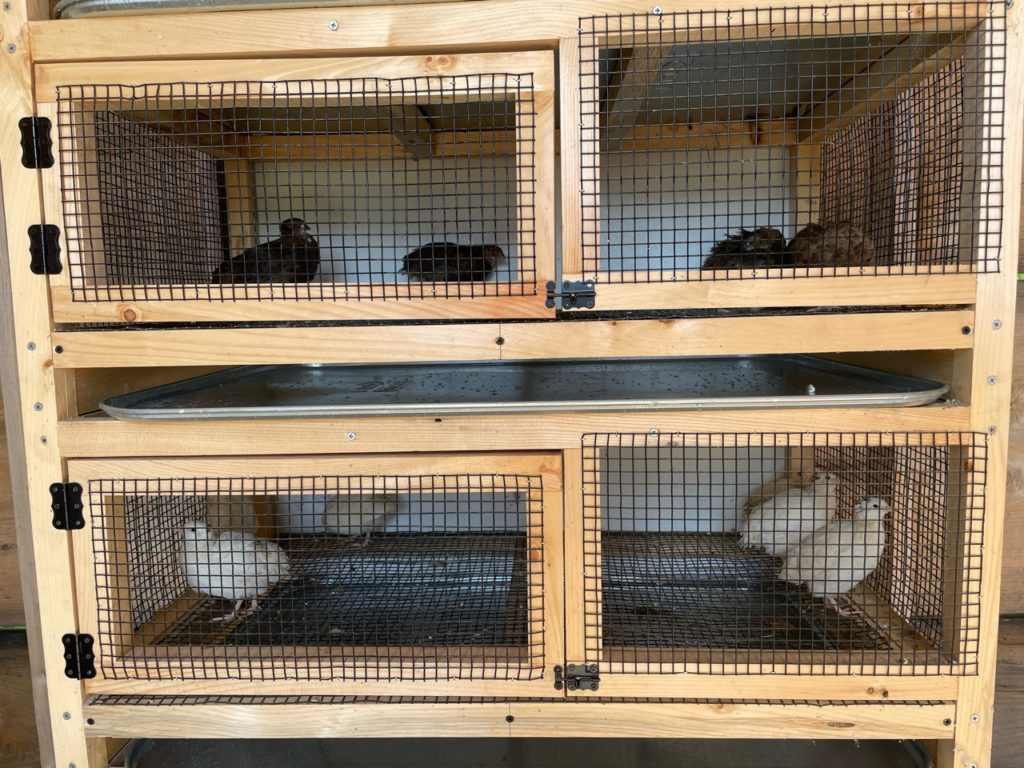
Choosing the right housing for quail
What kind of coop do quail live in?
For a poop-tray collection style floor, use 1/2″ mesh hardwire cloth. Make sure to use vinyl coated hardwire cloth to prevent foot sores. Their feet are much more dainty with thinner skin than chicken feet. We used a rollaway design in the laying cages with a slight tilt to collect the eggs. As the quail eggs are laid, they gently roll into to a tray just out of their reach. They lay willy-nilly all over the floor, and a rollaway design reduces reaching in their cage and causing any unnecessary ruckus (see “startling” below). This also keeps the eggs cleaner. Of note, I have never had any quail become egg eaters.
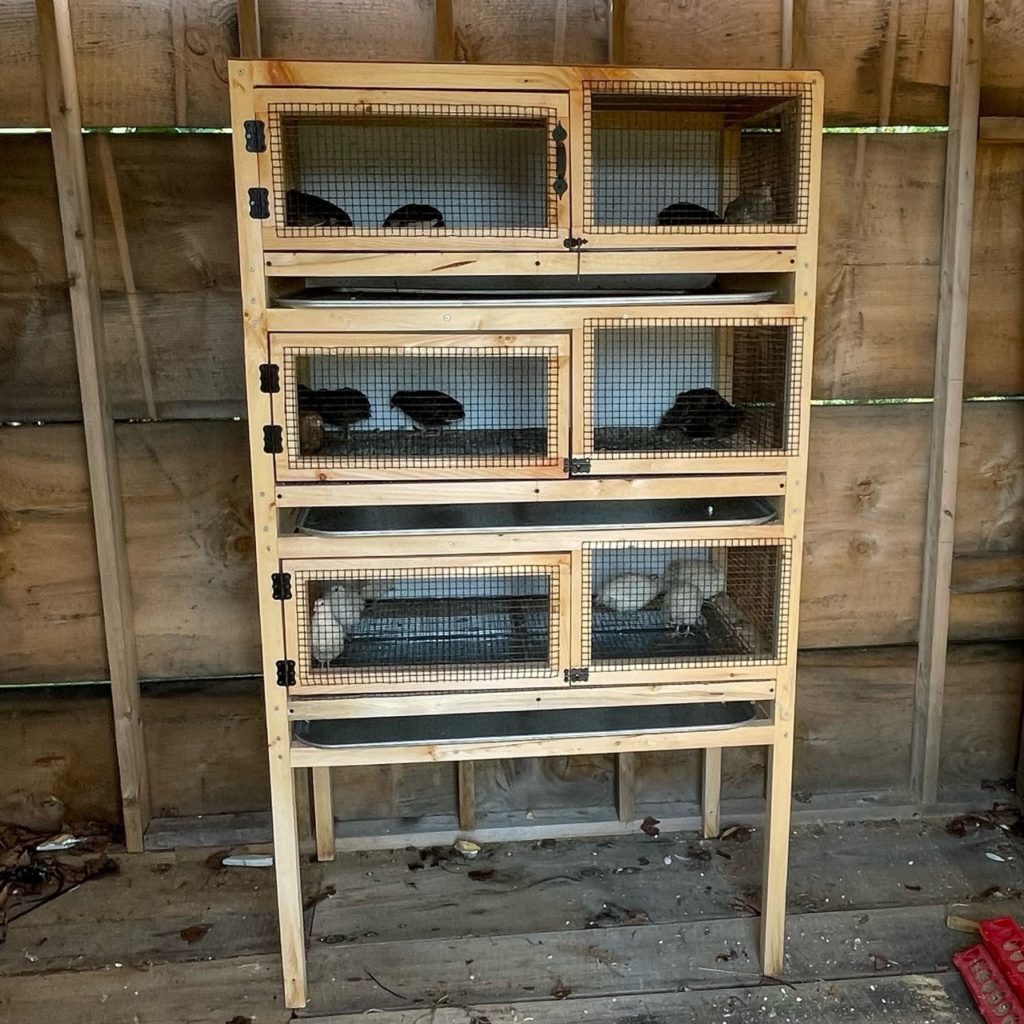
Ventilation is important to consider. Celadon quail manure produces substantially more ammonia than chickens. The poop trays should be scraped and hosed down weekly.
Keeping quail in winter
In nature, quail hide in hollow stumps, deep leaf litter and under low evergreen bows that touch the ground to avoid the elements and hide from predators. Although hardy, you must take care to provide them with enough shelter to huddle in on the coldest days.
If you are in a cold climate, like Maine, their tiny eggs freeze quickly in winter and should be sheltered from drafts.

Providing supplemental heat in extreme cold
Do quail live through the winter? Do quail need a heated coop?
I used a seedling starter mat for a gentle, even heat source. It was only used when it was below freezing inside the barn, not just the forecasted temps. Do not allow direct contact with the mat. The whiplash of hot-cold-hot-cold during a serious cold snap is just asking for illness. Place thick cardboard or thin piece of wood over the mat, and replace it often for cleanliness. The heat will raise through the protective layer providing a gentle even space to lay on. I highly recommend a timer for those who work off the farm, have demanding schedules—or just tend to be forgetful. Use the timer to have the mat turn on at dusk and off at dawn. When they are active during the day, they need the heat less.
Boost quail egg production in the winter
Do quail lay eggs in the winter?
We also used a timer system in the barn for supplemental lighting to boost egg production, extending the day a few hours in the deepest freeze. Be sure not to extend the natural light too long, it can lead to exhaustion, which in turn can lead to stress, fighting and picking behaviors.
Quail startle easily and act wild
Are quail friendly?
Move slowly around quail, especially when they are juveniles. Give them an opportunity to settle away from where you are working, like when you are cleaning their pen and collecting eggs. Often this will make no affect on their behavior. Even after hundreds of years of domestication, quail tend to act wild and startle very easily.
If startled, quail can break their necks on the top of their enclosure. To prevent this from happening, consider this when purchasing or building their home. Either have a very high ceiling that they will not reach when startled, or a very low one so they won’t have enough momentum to hit when they “pop”. Alternatively, a soft, loose material (like burlap) can be stretched across the ceiling of their housing to soften the blow.
Placement of housing can make all the difference
Place or build their enclosure away from ruckus. Passing cars, dogs runs, busy children, and abrupt loud noises should be avoided to reduce this behavior. A dark blanket can be gently draped over the cage during times this cannot be avoided, like when mowing the lawn.
Make a habit of softly announcing your presence, saying the same thing each time, before they catch sight of you. Hands-on care and delicate, friendly handling from an early age will reduce this instinctual behavior. Offer treats and teach any little farmers in your family to slow down when approaching. We have an eight-year-old farmer, so I understand how challenging this can be.
Quail chick care tips
What do your feed quail chicks?
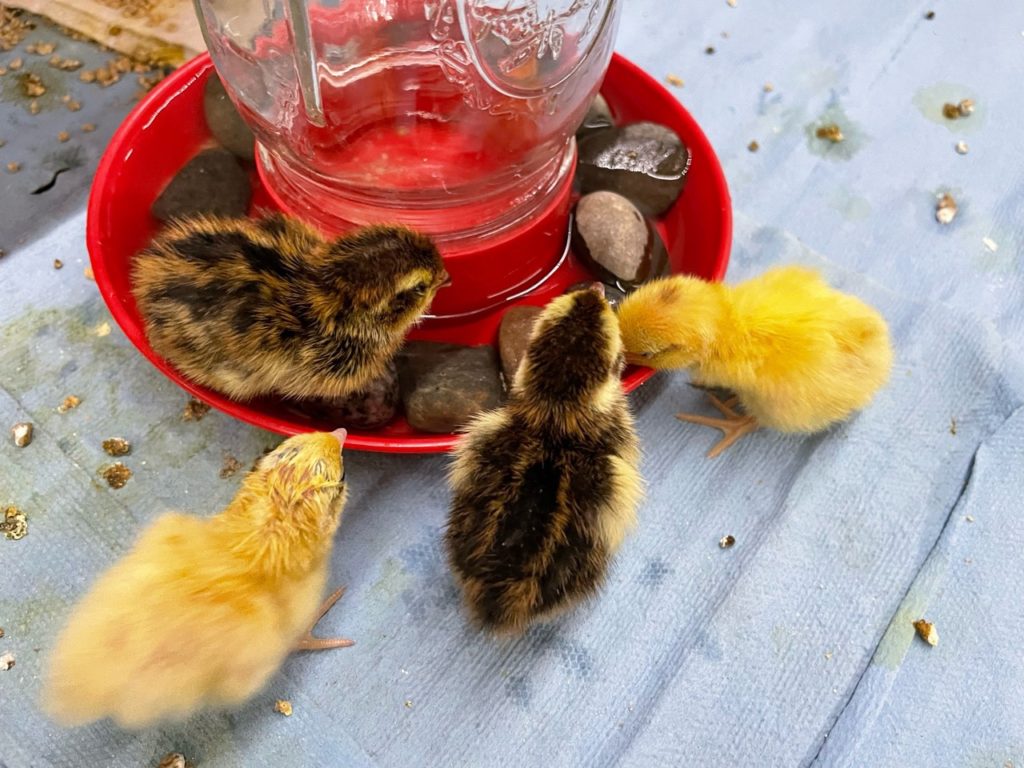
When the first quail chicks emerge, have food ready the second their teensy little feet touch the brooder floor. Sprinkle it on a paper towel around their feeder for the first day. They naturally forage and scratch, and this method seemed to get them to eat more right away. I found that hatchlings I fed with this method matured slightly faster, and laid eggs on average three days sooner.
Due to quails rapid maturation and high metabolism, quail chicks require high protein feed. Most feed stores will carry a starter crumble for game birds, which should be adequate.
Safe waterers for quail chicks
Provide drinking water changed twice daily. Use pebbles in the water tray of whatever waterer you use until they are at least 2 weeks old. It’s all about making sure they have traction to hop out, and shallow enough so they don’t slip and drown. There are specialized waterers made for quail, but we had a lot of standard chick waterers on hand that worked just fine. I did try a quail waterer, and due to overconfidence in the specialty design I didn’t use pebbles. I was devastated to have lost a chick to drowning even in the narrow tray made specifically for quail. I was away from the barn for less than 20-minutes, and that was all it took to lose a quail chick. Young chicks of all species are so fragile in their first few days. Using standard chick waterers gives folks who raise standard size poultry one less things to purchase, and to store in the off-season. Brood quail chicks otherwise as you would chicken chicks.
As their first true feathers come in at about 3 weeks old I introduced chopped mealworms to their diet. They should be chopped to reduce the size and for easier digestion. The oils and proteins are excellent for feather building.
Adult quail dietary needs
At full maturity, quail require a feed which contains 18-20% protein. Some specialty quail feed mixes contain a variety of seeds as well as crumble. These can be pricy, and game bird layer crumble is sufficient when supplementing leafy greens. Adult quail eat around half an ounce of food per day in optimal temperatures.
We grew alternative feeds to harvest on our homestead including; amaranth, comfrey, and clover. The comfrey and clover are permaculture fodder, which can be harvested throughout the summer as needed, then cut in the fall to dry for winter. These permaculture plots were chosen because they don’t just tolerate trimming, they thrive on it when timed correctly.
Four heads of amaranth will be enough to reseed the patch they are growing in this year, making all three plants incredibly sustainable, even though amaranth are annual in Maine. Amaranth can produce as much as a pound per stock, is fairly inexpensive. The downside is that amaranth has a long growing time for Maine’s climate.
We also fed the adults live mealworms to boost the protein in their diet, in addition to dead beetles from our mealworm farm for the winter months. The increased fat content of adding mealworms to our celadon quail feed is required for the bitter winter months here in Maine.
Quail make a mess of their feed
Where can I find a waste-free quail feeder?
We searched high and low for waste-free quail feeders. We tried making them out of all kinds of things as suggested on YouTube and various websites, and even bought a few types. None of them worked, so we invented our own. My husband designed one for our CNC router with a software program. The router cut the sides, top and bottom, and an inner double wall out of plywood. It looked like puzzle pieces, which we easily glued together.
It had holes just big enough to stick their head through that were about 2″ off the bottom, then an inner box that contained the food with thin slits along the bottom the quail could pick at. The food that came through the slits of the inner box was then trapped below their heads where they could eat it, but were unable to drag it out. We found the holes needed to be a couple inches apart or they would peck the crumble with such ferocity that it would fly out the next hole over if there wasn’t another quail’s head in the next hole too. This worked way better than simply drilling holes in a single-wall plastic container.
Quail laying & Lifespan
When do quail start laying eggs?
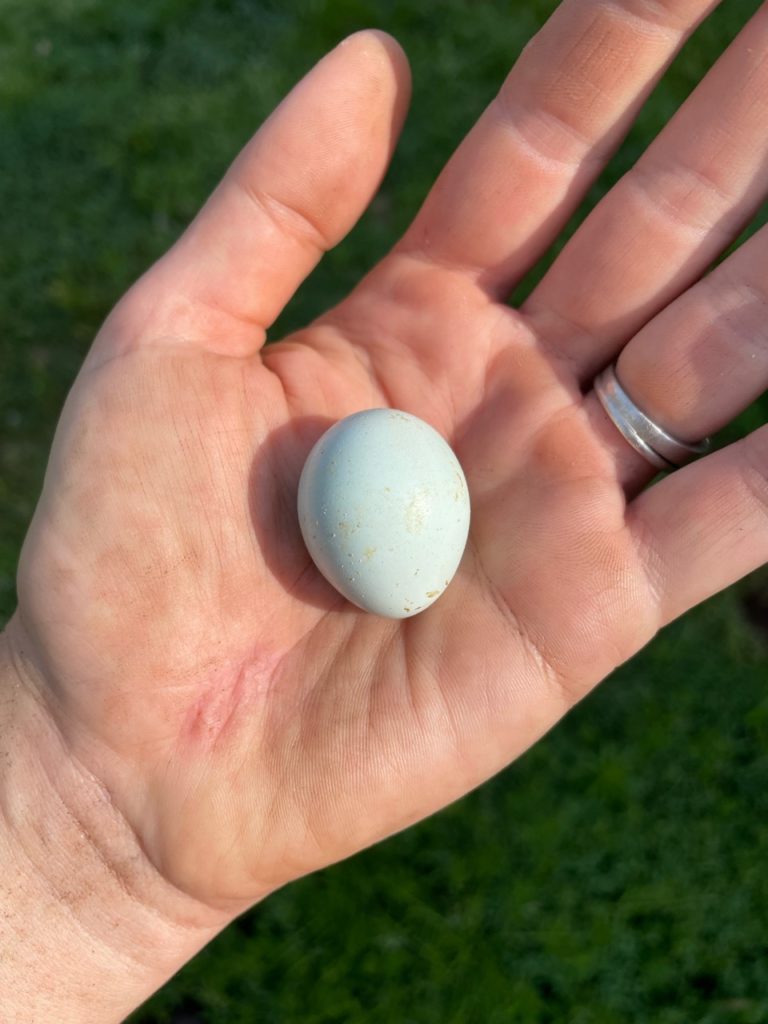
These amazing little feather babies begin to lay between 6-8 weeks. Quail lay the most in their first year, and often just as much in the second, until they reach between 2 years old when the laying slowly but gradually tapers off. This photo of our first egg was laid at only 5.5 weeks.
In an efficiency-based homestead system, it’s ideal to butcher or sell hens at 2 years old and replace them with new layers. Quail that are fed a balanced diet, kept in optimal housing, and not over crowded, may live as long as six years and will continue to lay.
Quail habits and housing needs
A bored quail is a naughty quail.
Provide an area with branches to climb on and to go under to provide them with things to do in open-concept enclosures. Change it up a little each time you check for eggs and clean. Dust baths are a must. Quail will spend hours preening themselves. Boredom and lead to feather picking, squabbling, and reduced productivity.
Breeding quail
What is the best hen to rooster ratio for quail?
Too many males in an enclosure will cause dominant males to literally scalp or peck the eyes out of smaller males. This kind of stress reduces mating, because the new goal of the roosters in the cage is to win mating rights instead of simply mating. In gleaming information from several resources and the breeders I have purchased from, I recommended five hens for each rooster, in no smaller than a 6-square-foot floorspace per breeding set.
Breeding sets should be limited to no more than two roosters ever being in the same cage or enclosure. We used a shelf-like unit with three cages. Each of the three cages were 6-square-foot with 10 hens and 2 roosters each. Keep one rooster in each compartment instead if this poses an issue, but never more than 12 total mature birds.
Rooster rotation saves on feed costs, housing space and hen overbreeding.
Alternatively, to save on space, feed and overbreeding keep only a few quail roosters and rotate them between hen enclosures. Hens will consistently lay fertilized eggs for one week after removing the males, and for up to three weeks with diminishing viability at time passes. So for best practices for those who plan to hatch or sell fertilized eggs, ensure all hens are serviced by roosters at least once weekly.
Much like with chickens, two roosters who are raised together and never separated will likely continue to be friendly and share a healthy ratio of hens without issue. Once you separate quail roosters, even for a day, they are have been known to fight to the death. This fighting causes stress for the entire population of that enclosure and prevents them from doing their duties. This means you’ll possibly lose a rooster and have infertile eggs.
If you do choose to use the rooster rotation method, make careful considerations when choosing which roosters to keep for your long-term breeding goals. Everyone has their own interests and ideas about what traits to select for. An easy one is weight, but more commonly breeders will aim for specific plumage color or pretty egg color. My recommendation is to choose for more than one of these traits. For example, I kept the darkest blue egg laying hens in the first cage, the heaviest hens in the second cage, and my favorite plumage color in the third cage.
Because we used our quail as a food source, when I chose roosters I would pull all the ones of my favorite color and weigh them. The heaviest two of that preferred color would stay. I would separate hens to figure out what egg color and size individuals laid. The hens who laid the tiniest eggs and the palest blue eggs would be culled.
Keep genetics in mind when selecting for breedings
Given the rapid maturation, the selection process is much quicker than with chickens—but on the flip side, inbreeding so many short generations can quickly become an issue. I recommend that larger operations with higher turnover keep separate lines, cross them every four generations, and band them to keep track. Keep your original hens, regardless of your breeding preferences, to cross back should you run into mutations, health or developmental issues. I banded eight original hens, and ordered more hatching eggs from another farm to breed with them after running into some problems with hatchlings several generations in.
Immediately remove injured birds as they will continue to be picked on, likely to death. Do not take this warning lightly.
As these birds served as a food source for our family on our homestead, we culled and consumed any injured quail immediately. If you will be keeping them as pets, have a plan for this before purchasing quail hatching eggs, just as you would for hatching out too many roosters in a chicken flock.
Preventing quail predation: keep your quail safe
Lest not forget: where there is grain, there lives a rat.
Rodents can quickly become a problem because Celadon quail are instinctually ground dwellers and leave their eggs laying around. The small size of the eggs and chicks make them especially easy to carry off by tiny predators. Keep this in mind when considering how to house quail to ensure security in their runs and housing.
We built a three-compartment stacked cage system on tall legs and completely enclosed by 1/2″ hardwire cloth. It was be inside our barn, safe from the elements, larger predators, and from startling.
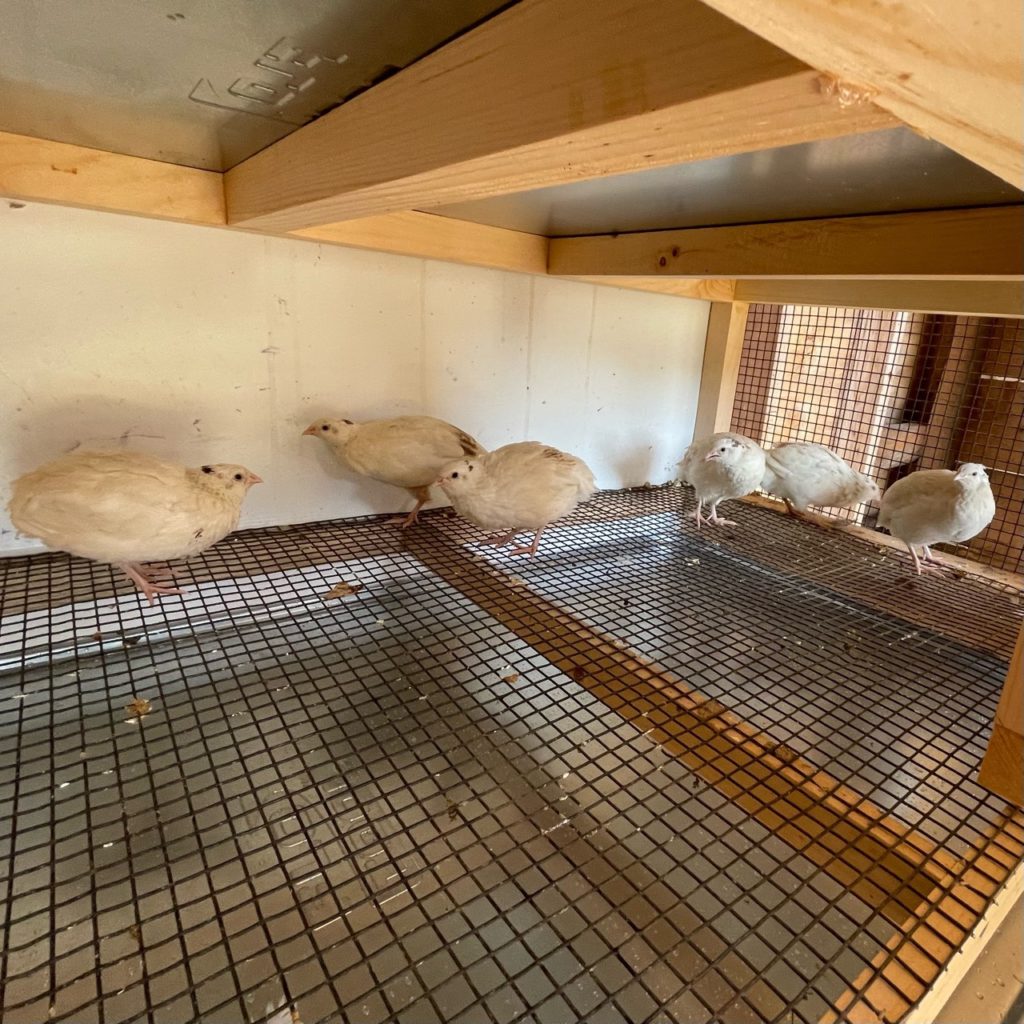
Setting a trap around their enclosure on a regular basis couldn’t hurt. I stuck one in the middle of milk jug. I cut the end off to put the trap in, then taped it shut, so any escaped poultry or other pets cannot get hurt. Mice wander into the milk jug lid which i lightly smeared with peanut butter and SNAP.
A section of PVC pipe can be used for this method for rat traps. Set the trap, and gently slide it in with a stick so it’s out of pecking-distance. I use raisins smooshed onto the little bait holder with peanut butter smeared over it. Works like magic.
Celadon Quail are a variety of Coturnix Quail
What kind of quail lay blue eggs?
Celadon Quail are a variety of Coturnix Quail, which carry the rare, recessive celadon gene, resulting in blue eggs. Coturnix quail were originally known as Japanese quail before they were imported to the US in the late 1800’s from Europe and Asia. Coturnix Quail are the hardiest of the quail species, and most commonly raised for egg and meat production. They have larger eggs and bird size then the more ornamental Celadon variety. Even though homesteads are about self-sufficiency, doesn’t mean you can’t enjoy a little egg bling. Slightly smaller yields are a tradeoff for adorable blue eggs—one I was willing to make for our homestead. And if you’re selling eggs, they are much more coveted and therefore worth more.
Where do quail come from?
Are there wild quail?
Quail belong to the same biological family of chicken and pheasants (Phasianidae). Wild quail are widespread over large areas of Asia, Europe, and Africa. They were first domesticated in Japan, and given their growing population, commercial quail production started in the beginning of the 20th century. After that, its commercial production became widespread in China and Europe. Japanese quail is used for egg and meat production chiefly in Middle East and America, but also in the Asia and Europe. In Europe, the highest consumption of quail meat is in France, Italy, and Spain. To learn about wild quail, visit Quail Forever.
